- HOME
- Website Building
- About Us Pages
- Telling Your Business Story Through the About Page
Telling Your Business Story Through the About Page
- 10 Mins Read
- Posted on April 17, 2018
- Last Updated on October 8, 2024
- By Lauren
Once you’ve identified your target audience, and once you’ve articulated what you can do for them, give them what all readers crave: Give them a story.
We humans are hardwired to respond to stories; we always have been. (Indeed, one need only think about cave paintings—the earliest storytelling technologies we had—to recognize that our capacity to tell stories is one of the things that makes us definitively human.)

Apart from their role in human evolution, stories engage our brains in ways that facts and figures don’t, which means that they improve engagement. Storytelling also creates a connection in a way that data, facts, figures—even photos of your team—simply can’t. Stories inspire action. They help your visitors identify with you, and that inspires trust.
Your company is out to make a profit, sure. But it exists for several other reasons, too. You could have chosen to get into any business, in any industry, but there’s a reason you chose the one you chose. That reason has a story behind it. That story is what makes you unique in an industry of competitors with similar products.
Take Glitter and Grit’s About page, for example:
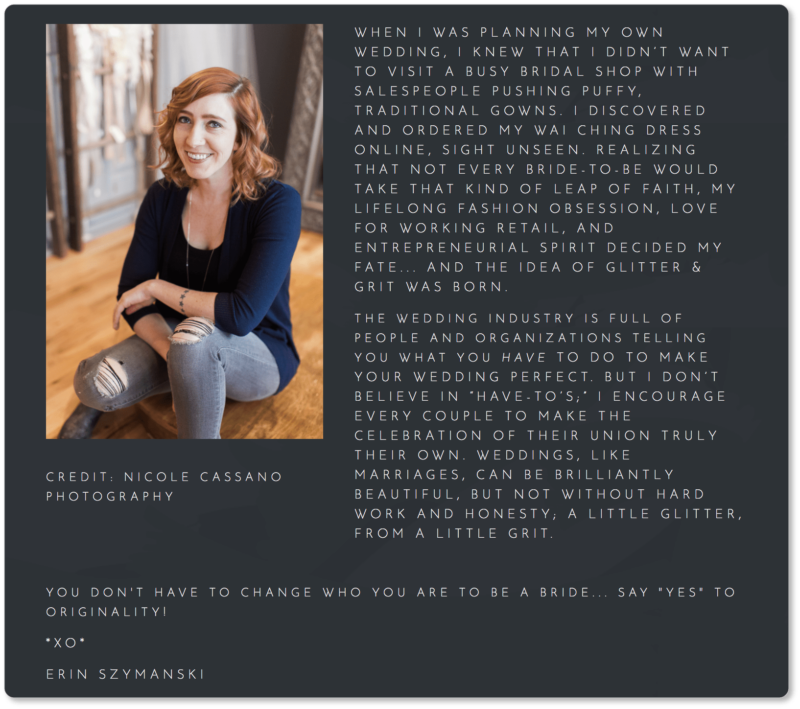
There are thousands of bridal boutiques out there; but Glitter and Grit’s narrative stands out among them. The site tells the story of one person who took a “leap of faith” on her wedding day (and hardly the kind of leap of faith we typically associate with wedding days!)
Erin’s story is bound to create an emotional connection with others who want to step outside the box of what a traditional wedding is “supposed” to look like. What’s more—because Erin is clear about her ideal prospect—visitors who come to Erin’s site wanting a traditional dress immediately know that her business is not for them.
Huit Denim’s About page tells the story of the meaningful role jeans manufacturing played in a small town for thirty years… until one day, it didn’t. Their story is one of renewal and revival—composed in short sentences, and almost in storybook form. The hopeful tone of their page (“Here goes”) has you cheering for Huit as they try to breathe life back into the town of Cardigan:
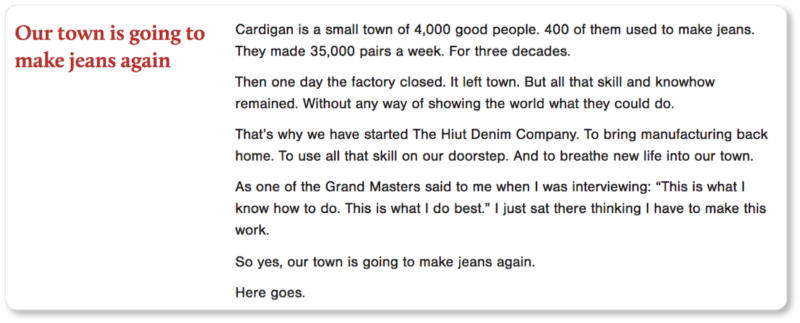
Yellow Leaf Hammocks’ About Us page tells the story of a company that’s out to empower artisan weavers in rural Thailand. The company trains women to weave their hammocks and enables them to make a living for their families, breaking the cycles of poverty in Northern Thailand—all while “spread[ing] good times and relaxation around the world.” (Note their benefit-oriented headline):

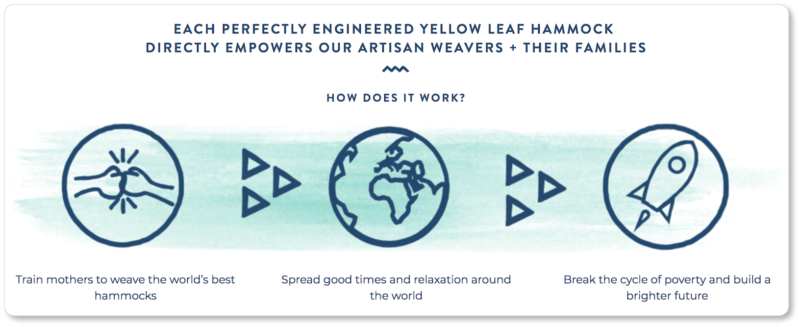

It should go without saying that if your business is out to change lives—or, moreover, to change the world—with its product or service, your About Us page is the place to mention it. Good stories are, by nature, “sticky,” but stories of hope and positive change are among the stickiest out there. People are more likely to connect with these types of stories—and to pass them on—than any other.
You may be looking at the stories on these About pages and feeling as though yours doesn’t “add up.” But remember that every brand has a story to tell. Take some time to reflect upon the experiences you’ve had in the course of running your business: the moments you’re most proud of, the ones that make you laugh out loud, the ones that still make you wince when you recall them.
Maybe it was the day you first opened your doors, and the conversation with the first customer who ever crossed your threshold. Maybe it was your very rocky first year, and your team’s refusal to throw in the towel. Maybe it was your five-year anniversary when you looked around during the party and felt utterly gratified at the team you had built.
You get the point. Your story should focus on a poignant emotional moment. Focus on what makes your company human.
Reflect your values
We’ve already touched on this, but it’s worth reiterating: Customers don’t always choose the companies they work with because of the products or services they offer. They often choose the companies they work with because they share that company’s values. So make sure yours are clear. Your About Us page is where your visitors will go to make sense of your whole vision… and your vision absolutely includes your values.
Essentially this means you have to stop answering the question “What?” and instead answer the question “Why?” Why have you chosen this product or service? Why do you believe in it? Why are you committed to it?
No matter what industry you’re in, you have a set of core values that you work with. They’re the things that get you out of bed every morning. And aside from the great products you make or stellar services you provide, they’re the reasons your customers trust you.
Example #1: Radiant Plumbing
The About Us page of Radiant Plumbing in Austin is an admirable example. Think there aren’t any core values that plumbers work with? Think again. Here’s the video on their About page. If we lived in Austin, we might clog our sinks on purpose just to get to spend time with these two:

One of the significant upshots of focusing on your company values is that it helps thwart any inclinations you might have to exaggerate about your product or service (as we’ve mentioned before, we strongly recommend cutting any hyperbole on your About page). Not every company can be the “best,” “foremost,” “fastest,” “most avant-garde,” “nonpareil” company out there. But every company has values that played a fundamental role in its foundation.
If there’s a charitable element to your company, absolutely mention that here. Your prospects will be pleased to hear that you’re not just out to make money. It’s also gratifying for them to know that they’re not just making a purchase for themselves, but that their purchase helps others, or is in the service of a larger cause (remember the example of Yellow Leaf Hammocks).
Example #2: Marmoset Music
Marmoset Music offers their core values in the fourth paragraph of a very well-written About page:
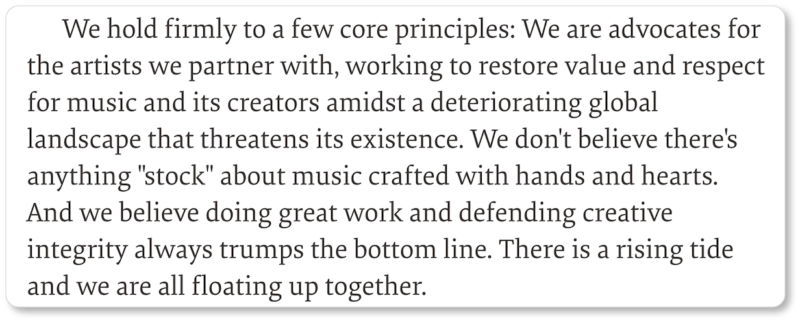
Marmoset Music prizes respect for creative artists—and valuation of their work—above revenue (“the bottom line”). Its statement of core principles closes on a strikingly hopeful note: a vision of a future world of “value and respect” for musicians that the prospect is already included in by virtue of the pronoun “we.”
Hopefully you already know what your company’s core values are. If you’ve written a mission statement, for example, you’ve done some of this work. But it may be worth sitting your team down and asking them what they think your company’s core values are.
You might learn something about how those core values shaped the company culture. And you may be pleasantly surprised to hear your employees discuss how those values influence the ways they approach their encounters with your customers and clients.
Let your business speak through employee bios
You can workshop your About page until it strikes exactly the right chord; but in the end, it’s still just one highly polished version of your company story. Bolster the claims you’re making by giving your employees a chance to describe what they do in their own words.
The easiest way to accomplish this is by displaying the faces and bios of your employees prominently on your About Us page. Offer some unusual biographical details about the people on your team, alongside their expertise and qualifications. Is your assistant manager a competitive salsa dancer? Does your marketing manager take pottery classes on the weekends?
The Nerdery has a dedicated About page for its leadership. The bio of its Chief Strategy and Operating Officer ends like this:

Here’s a bio from Zoho’s Communications team that showcases one of the personalities that makes our company tick:

You might consider a page design in which visitors can click on an employee image and be taken to a page dedicated to that team member, with details about what they do for the company, as well as what they like to do outside of work. This allows each team member to be as quirky (or not) as they choose.
It also puts faces to the names of people your prospects might speak on the phone or exchange e-mails with, and makes prospects more likely to reach out to those people. (Not to mention that the employee subpages keep a single About page from getting way too long.)
The story you offer your prospects will humanize your company; the bios of your employees should cement it. By the time your prospects see your team’s photos, your company should seem wholly approachable.
Use timelines to demonstrate longevity
What’s the only thing more reassuring for a prospect than a poignant company story?
A poignant company story about a company that’s been around for a long time.
Your business’s longevity suggests a lot to your prospects. It suggests that you have authority—perhaps even mastery. It indicates your capacity to problem-solve, to be fluid, and to transform with the times. It implies that you have a finger on the pulse of your industry, and that you’ve been able to maintain longstanding relationships with your clients all this time. Which is to say, it suggests a lot about your character.
What’s more, it indicates that you’ve indeed got a really good product or service on offer.
Of course, if you have been around for awhile, you don’t want to bog your visitor down with page after page of company history.
This is when a timeline might come in handy. While it shouldn’t stand in for your story, it can be a great addition to your About page, because it addresses a universal concern for your visitor: Can they trust you to still be around a year, two years, five years down the road?
Pro tip: Timelines work well not just for businesses with long histories, but also for small family-owned businesses. Communities tend to strongly identify with the narratives of their local family businesses.
The timeline on Moz’s About page is a great example (and this is only a portion of it):
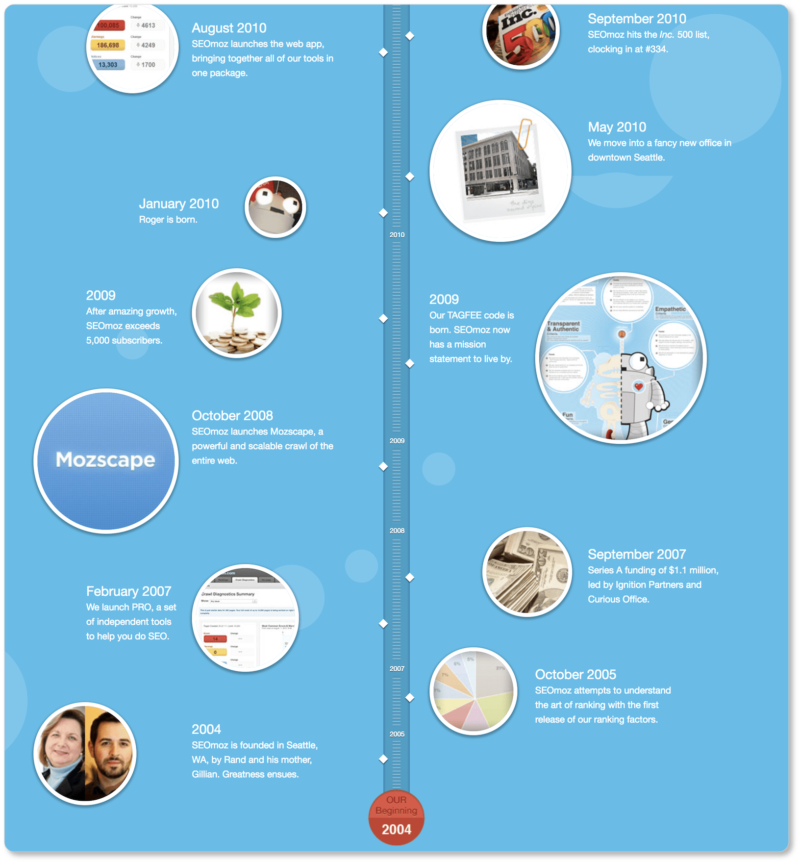
Timelines offer a number of advantages:
- They allow your visitors to feel as though they’re a part of your story
- They demonstrate how you’ve grown and evolved—and what you’ve achieved—since your launch
- They give visitors a better (visual) sense of your company chronology than plain copy does
If your company is too new for a timeline, that’s okay! Tell your readers why now is the time that a business like yours needs to exist. Offer an anecdote about how you got started. Talk about the experiences that brought your company’s founders together. (Your business may be new, but your founders are probably not new to the industry. What do they bring to the table? Why this particular collaboration, now?)
Forecast the future
While your About page will definitely focus on your company’s history, don’t forget its future. Be willing to share your dreams and your vision of where your company is going.
What do you hope to accomplish in the next five or ten years? Where do you envision your business making inroads and advancements in your industry? What has your growth been like in the past few years—and what does it look like it will do from here? Are you on the verge of opening new stores? Creating new products? Growing your internal team?
The About page for the Silicon Valley Pet Project includes a section called “Our Goal—A Community Center.” Although SVPP is only three years old, the About page describes the organization’s five-year plan to site visitors. Not only do they detail what their future community center will entail; they also describe the steps they’ve taken thus far toward that imagined future:

You could even include a forward-looking segment on your timeline that addresses hopes, dreams, and expectations you have for your business. This kind of public proclamation is an excellent way to hold you and your team accountable for fulfilling those goals.
A future-looking gesture will also signal to your site visitors that you are dynamic and enterprising, confident about your prospects, responsive to your industry, and committed to your vision.
Let your About page evolve with you
We’ve offered examples of both small businesses and large companies in our examination of About pages. The latter are there as examples of where you might go eventually. But don’t let these grand examples set an impossible bar if you’re creating an About page for the small business you run out of your basement. Don’t lose sight of who you are in the process of trying to create the best About page possible.
Even once you’re happy with the content, you should be updating your About page regularly. As your company grows and evolves, so will the size of your team, and so will your role in your industry… and so will the stories behind your business.
Your About page should always be an accurate reflection of what your company is in this moment, and should mirror what you would say about yourself today. So go back to the page every few months and be sure it reflects the company that is living and breathing right now.
That, after all, is what your prospects are looking for when they click into your About page.
In the final section, you’ll learn how to create a more conversion-friendly About page. Now that you’ve positioned your About page correctly and chosen the right language and tone, it’s time to think about how to drive prospects further down your sales pipeline.






